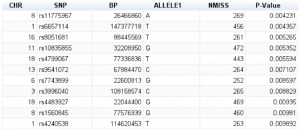Michael Peterson and Dr. John Kauwe, Department of Biology
Introduction
A person’s predisposition to Alzheimer’s Disease is known to be influenced by both genetic factors as well as environmental factors. One know environmental factor is that known to affect risk for disease is early parental death. The purpose of this research is to better understand the complex factors that influence the disease by analyzing the relationship between the environmental factor of early parental death with genetic variants known to influence the disease.
Methods
We used extant data from the CCSMHA, an ongoing aging study including 89.7% (5092 of 5677) of all of the eligible residents of Cache County, Utah. This data includes information about environmental and psychosocial stressor of the subjects as well as information about physical examinations, metal screenings, and individuals’ genotypes at many loci that are known to be related to Alzheimers Disease. We used multivariate logistic regression to determine the effect of early parental death by SNP interactions on risk for AD. For the analysis we cleaned the data by removing SNPs less than a minor allele frequency of 0.01, a Hardy-‐Weinberg equilibrium value of 110-‐6, and a maximum missing snp call of 0.2. Individuals were also removed if genotyping rate was less than 0.2. After filtering we had 262 cases, 239 controls and 0 missing.
Results
Of the SNPs Identified as candidates through our analysis, rs7743899, rs11775967, and rs10835855 are on genes that have been identified with functions related to neurological physiology. rs10835855 and rs11775967 are both on genes that are involved with synaptic mechanism in the brain. The SNP that was associated with the lowest P-value, rs7743899 P-value 0.004231, lies in the protein coding region of the DPYSL2 dihydropyrimidinase-like 2 gene which has been implicated in multiple neurological disorders, and hyperphosphorylation of the encoded protein may play a key role in the development of Alzheimer’s disease. Alternatively spliced transcript variants encoding multiple isoforms have been observed for this gene.
Conclusions
Although these are preliminary results are not yet conclusive for a link between Alzheimer’s Disease, genes, and parental mortality data, these preliminary result hint at a possible connection and point to possible gene candidates that we can use in further analysis. We will continue to refine our data analysis to look further into our candidate genes to until we have more conclusive data to support or reject our hypothesis.
Acknowledgments
This work was funded by a Brigham Young University Office for Research and Creative Activities (ORCA) Grant. Information about genes and gene function was provided by the National Center for Biotechnology Information (NCBI)


